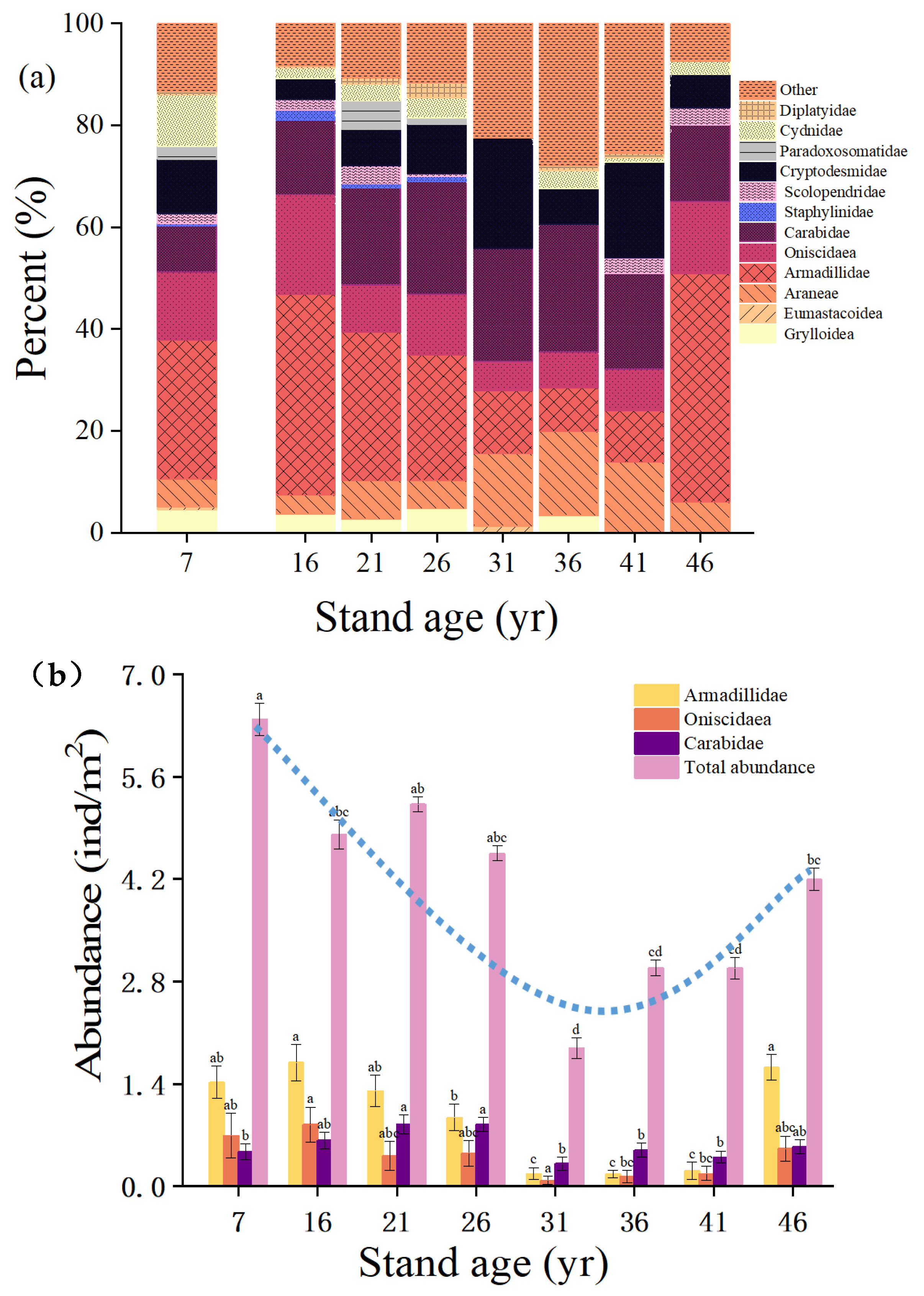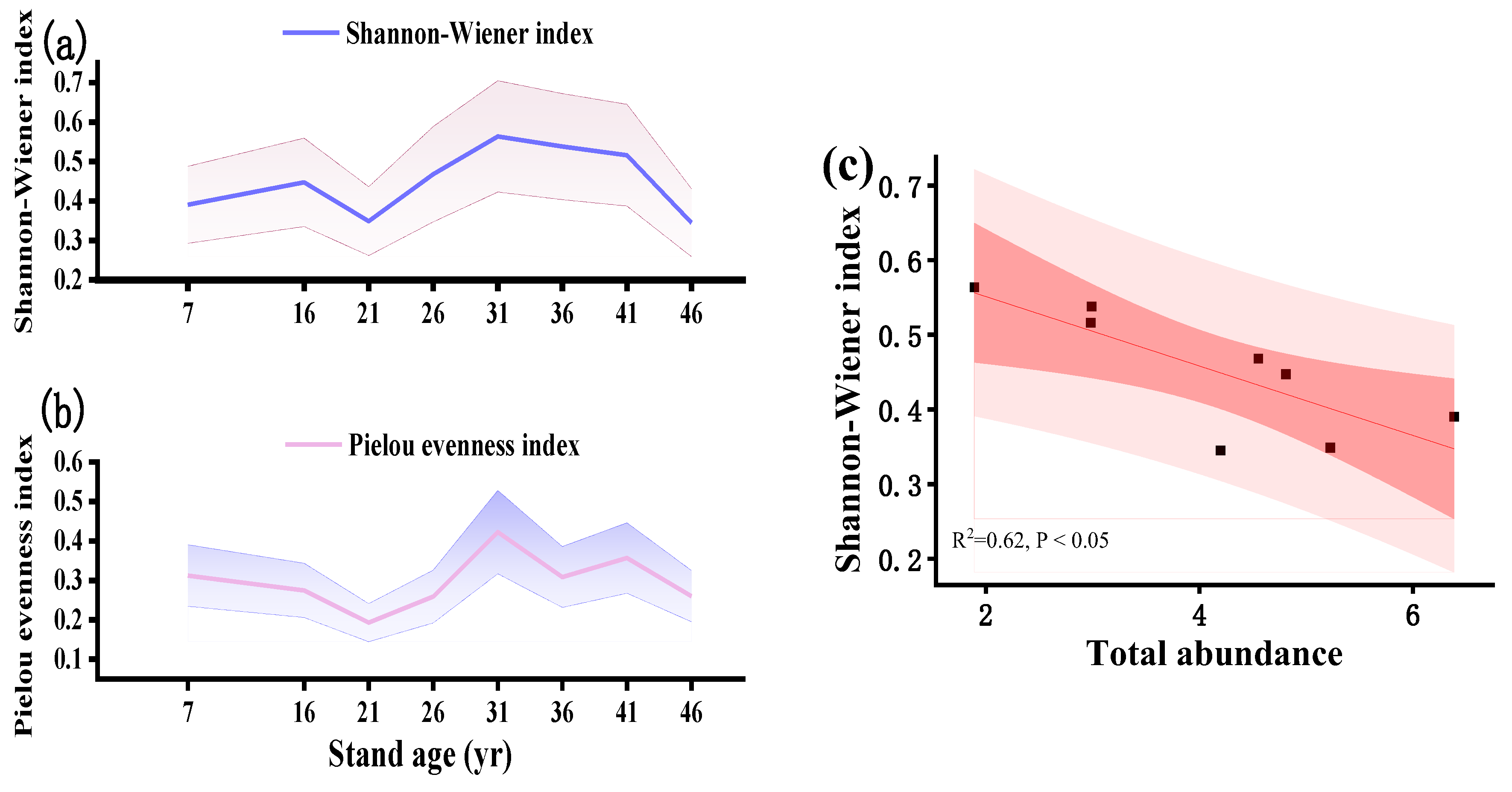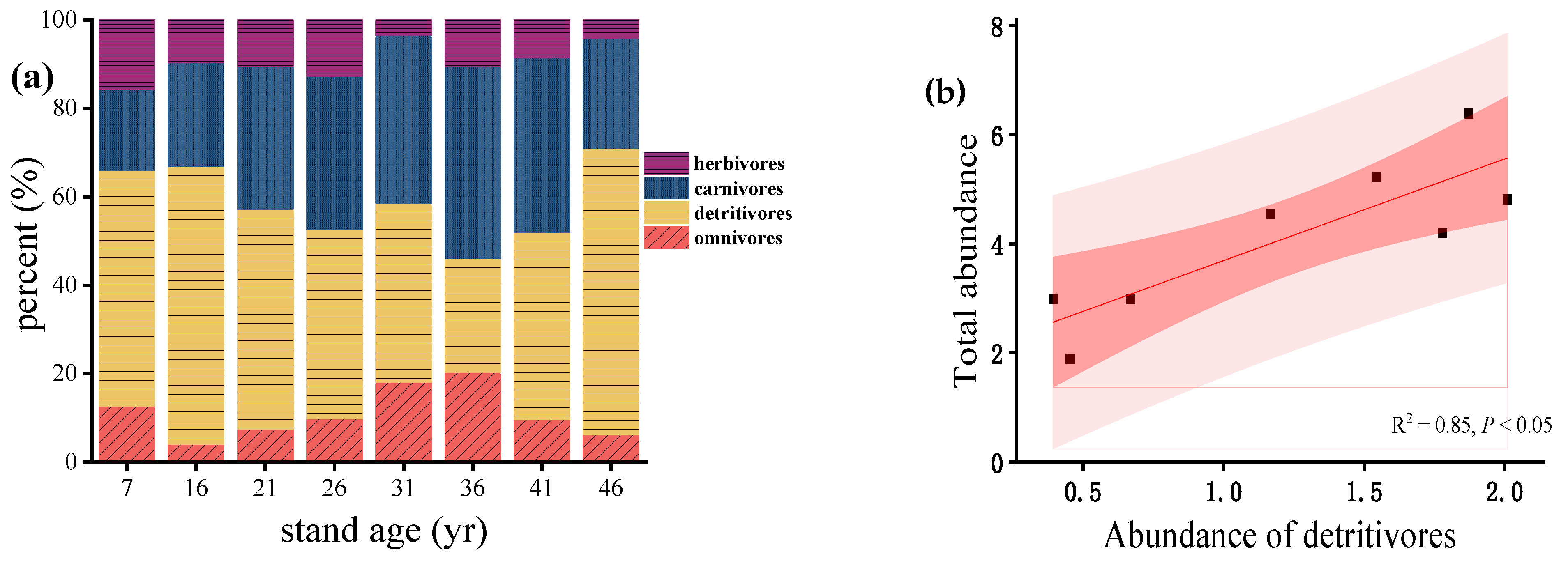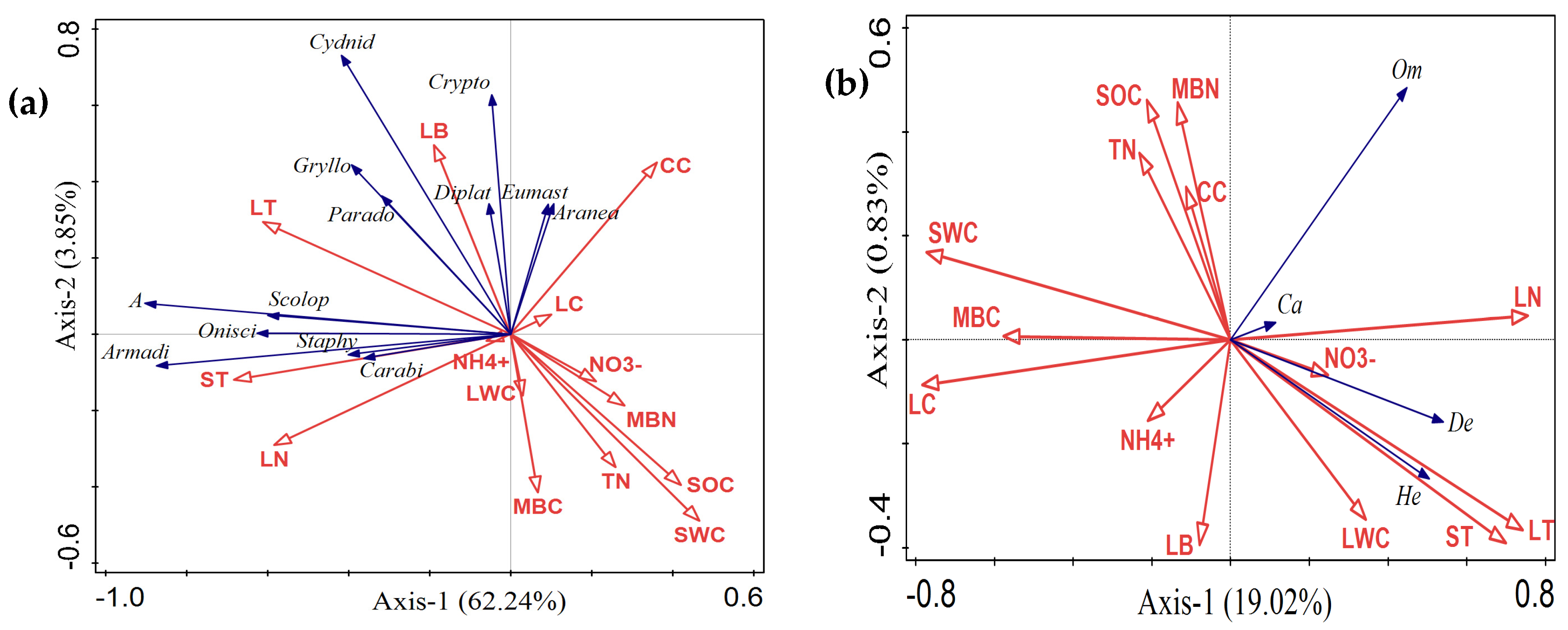Forest Development Determines the Compositions and Structures of Soil Invertebrate Communities in Reclaimed Coastal Lands
Abstract
:1. Introduction
2. Materials and Methods
2.1. Site Description and Experimental Design
2.2. Collection and Identification of Soil Invertebrates
2.3. Measurement of Soil and Surface Litter Physicochemical Properties
2.4. Statistical Analysis
3. Results
3.1. Composition of Soil Invertebrate Communities as Forest Development
3.2. Distribution of Functional Groups in Soil Invertebrate Communities
3.3. Associations Between Environmental Factors and Soil Invertebrate Communities
4. Discussion
4.1. Abundance of Soil Invertebrate Changes with Plantation Development
4.2. Relationships Between the Total Abundance and Diversity of Soil Invertebrates with Plantation Development
4.3. Relationships Between the Total Abundance of Soil Invertebrates and Functional Groups with Plantation Development
5. Conclusions
Supplementary Materials
Author Contributions
Funding
Data Availability Statement
Conflicts of Interest
References
- Wardle, D.A.; Bardgett, R.D.; Klironomos, J.N.; Setälä, H.; van der Putten, W.H.; Wall, D.H. Ecological linkages between aboveground and belowground biota. Science 2004, 304, 1629–1633. [Google Scholar] [CrossRef] [PubMed]
- Ellers, J.; Berg, M.P.; Dias, A.T.C.; Fontana, S.; Ooms, A.; Moretti, M. Diversity in form and function: Vertical distribution of soil fauna mediates multidimensional trait variation. J. Anim. Ecol. 2018, 87, 933–944. [Google Scholar] [CrossRef] [PubMed]
- Guidi, C.; Frey, B.; Brunner, I.; Meusburger, K.; Vogel, M.E.; Chen, X.M.; Stucky, T.; Gwiazdowicz, D.J.; Skubala, P.; Bose, A.K.; et al. Soil fauna drives vertical redistribution of soil organic carbon in a long-term irrigated dry pine forest. Glob. Chang. Biol. 2022, 28, 3145–3160. [Google Scholar] [CrossRef] [PubMed]
- Bardgett, R.D.; van der Putten, W.H. Belowground biodiversity and ecosystem functioning. Nature 2014, 515, 505–511. [Google Scholar] [CrossRef]
- Eisenhauer, N. Aboveground-belowground interactions as a source of complementarity effects in biodiversity experiments. Plant Soil 2012, 351, 1–22. [Google Scholar] [CrossRef]
- Carrillo, Y.; Ball, B.A.; Bradford, M.A.; Jordan, C.F.; Molina, M. Soil fauna alter the effects of litter composition on nitrogen cycling in a mineral soil. Soil Biol. Biochem. 2011, 43, 1440–1449. [Google Scholar] [CrossRef]
- Hedenec, P.; Jose Jimenez, J.; Moradi, J.; Domene, X.; Hackenberger, D.; Barot, S.; Frossard, A.; Oktaba, L.; Filser, J.; Kindlmann, P.; et al. Global distribution of soil fauna functional groups and their estimated litter consumption across biomes. Sci. Rep. 2022, 12, 17362. [Google Scholar] [CrossRef]
- Darby, B.J.; Neher, D.A.; Housman, D.C.; Belnap, J. Few apparent short-term effects of elevated soil temperature and increased frequency of summer precipitation on the abundance and taxonomic diversity of desert soil micro- and meso-fauna. Soil Biol. Biochem. 2011, 43, 1474–1481. [Google Scholar] [CrossRef]
- Payn, T.; Carnus, J.-M.; Freer-Smith, P.; Kimberley, M.; Kollert, W.; Liu, S.; Orazio, C.; Rodriguez, L.; Silva, L.N.; Wingfield, M.J. Changes in planted forests and future global implications. For. Ecol. Manag. 2015, 352, 57–67. [Google Scholar] [CrossRef]
- Xu, H.T.; He, B.; Guo, L.L.; Yan, X.; Zeng, Y.L.; Yuan, W.P.; Zhong, Z.Q.; Tang, R.; Yang, Y.; Liu, H.M.; et al. Global Forest Plantations Mapping and Biomass Carbon Estimation. J. Geophys. Res.-Biogeosci. 2024, 129, e2023JG007441. [Google Scholar] [CrossRef]
- Peng, S.-S.; Piao, S.; Zeng, Z.; Ciais, P.; Zhou, L.; Li, L.Z.X.; Myneni, R.B.; Yin, Y.; Zeng, H. Afforestation in China cools local land surface temperature. Proc. Natl. Acad. Sci. USA 2014, 111, 2915–2919. [Google Scholar] [CrossRef] [PubMed]
- Feng, J.; Liu, Y.-R.; Eldridge, D.; Huang, Q.; Tan, W.; Delgado-Baquerizo, M. Geologically younger ecosystems are more dependent on soil biodiversity for supporting function. Nat. Commun. 2024, 15, 4141. [Google Scholar] [CrossRef] [PubMed]
- Islam, W.; Saqib, H.S.A.; Adnan, M.; Wang, Z.; Tayyab, M.; Huang, Z.; Chen, H.Y.H. Differential response of soil microbial and animal communities along the chronosequence of Cunninghamia lanceolata at different soil depth levels in subtropical forest ecosystem. J. Adv. Res. 2022, 38, 41–54. [Google Scholar] [CrossRef] [PubMed]
- Warren, M.W.; Zou, X.M. Soil macrofauna and litter nutrients in three tropical tree plantations on a disturbed site in Puerto Rico. For. Ecol. Manag. 2002, 170, 161–171. [Google Scholar] [CrossRef]
- Zhang, L.; Zhang, P.; Yu, M.K.; Wu, T.G. Soil organic carbon content and stocks in an age-sequence of Metasequoia glyptostroboides plantations in coastal area, East China. In Proceedings of the 4th International Conference on Sustainable Energy and Environmental Engineering (ICSEEE), Shenzhen, China, 20–21 December 2015; pp. 1004–1012. [Google Scholar]
- Bird, S.B.; Coulson, R.N.; Fisher, R.R. Changes in soil and litter arthropod abundance following tree harvesting and site preparation in a loblolly pine (Pinus taeda L.) plantation. For. Ecol. Manag. 2004, 202, 195–208. [Google Scholar] [CrossRef]
- Scheu, S.; Albers, D.; Alphei, J.; Buryn, R.; Klages, U.; Migge, S.; Platner, C.; Salamon, J.A. The soil fauna community in pure and mixed stands of beech and spruce of different age: Trophic structure and structuring forces. Oikos 2003, 101, 225–238. [Google Scholar] [CrossRef]
- Xu, G.R.; Zhang, Y.X.; Zhang, S.; Ma, K.M. Biodiversity associations of soil fauna and plants depend on plant life form and are accounted for by rare taxa along an elevational gradient. Soil Biol. Biochem. 2020, 140, 107640. [Google Scholar] [CrossRef]
- Wang, G.L.; Chen, Y.W.; Liu, C.Z.; Hou, F.J.; Yang, B.S.; Wang, S.S. Effects of Eco-restoration of Abandoned Farmland on Soil Invertebrate Diversity in the Loess Plateau. J. Desert Res. 2010, 30, 140–145. [Google Scholar]
- Yang, X.; Shao, M.A.; Li, T.C.; Gan, M.; Chen, M.Y. Community characteristics and distribution patterns of soil fauna after vegetation restoration in the northern Loess Plateau. Ecol. Indic. 2021, 122, 107236. [Google Scholar] [CrossRef]
- Yi, L.; You, W.H.; Song, Y.C. Soil aninal communities in the litter of the evergreen broad-leaved forest at five succession stages in Tiantong. Acta Ecol. Sin. 2005, 25, 466–473. [Google Scholar]
- Wike, L.D.; Martin, F.D.; Paller, M.H.; Nelson, E.A. Impact of forest seral stage on use of ant communities for rapid assessment of terrestrial ecosystem health. J. Insect Sci. 2010, 10, 77. [Google Scholar] [CrossRef] [PubMed]
- Huang, P.S.; Lin, H.C.; Lin, C.P.; Tso, I.M. The effect of thinning on ground spider diversity and microenvironmental factors of a subtropical spruce plantation forest in East Asia. Eur. J. For. Res. 2014, 133, 919–930. [Google Scholar] [CrossRef]
- Ge, B.M.; Zhang, D.Z.; Cui, J.; Zhang, H.B.; Zhou, C.L.; Tang, B.P. Biodiversity Variations of Soil Macrofauna Communities in Forests in a Reclaimed Coast with Different Diked History. Pak. J. Zool. 2014, 46, 1053–1059. [Google Scholar]
- Moore, J.C.; McCann, K.; Setälä, H.; De Ruiter, P.C. Top-down is bottom-up:: Does predation in the rhizosphere regulate aboveground dynamics? Ecology 2003, 84, 846–857. [Google Scholar] [CrossRef]
- Yang, X.; Liu, R.; Li, T.; Dai, Y. Changes of soil fauna along the non-native tree afforestation chronosequence on Loess Plateau. Plant Soil 2023, 485, 489–505. [Google Scholar] [CrossRef]
- Zhang, Y.K.; Peng, S.; Chen, X.L.; Chen, H.Y.H. Plant diversity increases the abundance and diversity of soil fauna: A meta-analysis. Geoderma 2022, 411, 115694. [Google Scholar] [CrossRef]
- Ge, Z.; Fang, S.; Chen, H.Y.H.; Zhu, R.; Peng, S.; Ruan, H. Soil Aggregation and Organic Carbon Dynamics in Poplar Plantations. Forests 2018, 9, 508. [Google Scholar] [CrossRef]
- Walker, L.R.; Wardle, D.A.; Bardgett, R.D.; Clarkson, B.D. The use of chronosequences in studies of ecological succession and soil development. J. Ecol. 2010, 98, 725–736. [Google Scholar] [CrossRef]
- Deng, S.Q.; Yin, N.; Guan, Q.W.; Katoh, M. Dynamic response of the scenic beauty value of different forests to various thinning intensities in central eastern China. Environ. Monit. Assess. 2014, 186, 7413–7429. [Google Scholar] [CrossRef]
- Yin, W.Y. Subtropical Soil Animals of China; Science Press: Beijing, China, 1992; 618p. [Google Scholar]
- Ma, C.; Zhang, R.; He, Z.; Su, P.; Wang, L.; Yao, Y.; Zhang, X.; Liu, X.; Yang, F. Biochar alters the soil fauna functional traits and community diversity: A quantitative and cascading perspective. J. Hazard. Mater. 2024, 477, 135302. [Google Scholar] [CrossRef]
- Yin, W.Y. Pictorical Keys to Soil Animals of China; Science Press: Beijing, China, 1998; 756p. [Google Scholar]
- Potapov, A.M.; Beaulieu, F.; Birkhofer, K.; Bluhm, S.L.; Degtyarev, M.I.; Devetter, M.; Goncharov, A.A.; Gongalsky, K.B.; Klarner, B.; Korobushkin, D.I.; et al. Feeding habits and multifunctional classification of soil-associated consumers from protists to vertebrates. Biol. Rev. 2022, 97, 1057–1117. [Google Scholar] [CrossRef]
- Dong, J.H.; Li, R.J.; Zheng, W.F.; Liu, R.Y.; Zhao, L.J.; Gao, R.H. Elevation gradient distribution pattern and environmental driving factors of soil fauna functional groups in poplar-birch mixed forest in Guandi Mountain. Acta Ecol. Sin. 2025, 45, 1–19. [Google Scholar] [CrossRef]
- Chen, Z.B. Instumental Analysis Experiment; Fudan University Press: Shanghai, China, 2018; 105p. [Google Scholar]
- Drolc, A.; Vrtovsek, J. Nitrate and nitrite nitrogen determination in waste water using on-line UV spectrometric method. Bioresour. Technol. 2010, 101, 4228–4233. [Google Scholar] [CrossRef]
- Lu, R.K. Methods for the Chemical Analysis of Soil Agriculture; China Agricultural Science and Technology Press: Beijing, China, 2000; 638p. [Google Scholar]
- Zhou, H.Y.; Zhang, J.; Zhang, D.J.; Zhang, J.; Wei, D.P.; Zhao, Y.B.; Zhao, B.; Li, C.B. Community characteristics of soil fauna for different canopy density of a Pinus massoniana plantation. Acta Ecol. Sin. 2017, 37, 1939–1955. [Google Scholar]
- Shannon, C.E. A mathematical theory of communication. Bell Syst. Tech. J. 1948, 27, 379–423. [Google Scholar] [CrossRef]
- Simpson, E.H. Measurement of Diversity. Nature 1949, 163, 688. [Google Scholar] [CrossRef]
- Zhang, H.; Sun, D.Y. Effects of Different Ages of Japanese Larix kaempferi Artificial Forest on Litters and Soil Physicochemical Characteristics. Chin. Agric. Sci. Bull. 2016, 32, 12–16. [Google Scholar]
- Zhen, Y.F.; Li, X.; Wan, X.H.; Zou, B.Z.; Wang, S.R.; Huang, Z.Q. Changes of Soil Microbial Community Structure across Different Succession Stages of Secondary Forest. J. Subtrop. Resour. Environ. 2021, 16, 23–28+34. [Google Scholar] [CrossRef]
- Tong, F.C.; Wang, Q.L.; Liu, S.X.; Xiao, Y.H. Dynamics of soil fauna communities during succession of secondary forests in Changbai Mountain. Chin. J. Appl. Ecol. 2004, 15, 1531–1535. [Google Scholar]
- Diekötter, T.; Wamser, S.; Wolters, V.; Birkhofer, K. Landscape and management effects on structure and function of soil arthropod communities in winter wheat. Agric. Ecosyst. Environ. 2010, 137, 108–112. [Google Scholar] [CrossRef]
- Wei, X.X.; Chen, A.L.; Wang, S.Y.; Cao, G.Q.; Cai, P.Q.; Li, S. A comparative study of soil microbial carbon source utilization in different successive rotation plantations of Chinese fir. Chin. J. Appl. Environ. Biol. 2016, 22, 518–523. [Google Scholar]
- Tilman, D. The ecological consequences of changes in biodiversity: A search for general principles. Ecology 1999, 80, 1455–1474. [Google Scholar] [CrossRef]
- Staab, M.; Schuldt, A.; Assmann, T.; Bfuelheide, H.; Klein, A.-M. Ant community structure during forest succession in a subtropical forest in South-East China. Acta Oecologica-Int. J. Ecol. 2014, 61, 32–40. [Google Scholar] [CrossRef]
- Leibold, M.A.; Holyoak, M.; Mouquet, N.; Amarasekare, P.; Chase, J.M.; Hoopes, M.F.; Holt, R.D.; Shurin, J.B.; Law, R.; Tilman, D.; et al. The metacommunity concept: A framework for multi-scale community ecology. Ecol. Lett. 2004, 7, 601–613. [Google Scholar] [CrossRef]
- Ravenek, J.M.; Bessler, H.; Engels, C.; Scherer-Lorenzen, M.; Gessler, A.; Gockele, A.; De Luca, E.; Temperton, V.M.; Ebeling, A.; Roscher, C.; et al. Long-term study of root biomass in a biodiversity experiment reveals shifts in diversity effects over time. Oikos 2014, 123, 1528–1536. [Google Scholar] [CrossRef]
- Chen, C.; Chen, H.Y.H.; Chen, X.L.; Huang, Z.Q. Meta-analysis shows positive effects of plant diversity on microbial biomass and respiration. Nat. Commun. 2019, 10, 1332. [Google Scholar] [CrossRef]
- Li, N.; Zhang, X.P.; Zhang, L.M. Spatial and temporal variation of soil macro-fauna community structure in three temperate forests. Acta Ecol. Sin. 2013, 33, 6236–6245. [Google Scholar]
- Berg, M.P.; Hemerik, L. Secondary succession of terrestrial isopod, centipede, and millipede communities in grasslands under restoration. Biol. Fertil. Soils 2004, 40, 163–170. [Google Scholar] [CrossRef]





| Soil Fauna Taxa | Environmental Factors | ||||||||||||
|---|---|---|---|---|---|---|---|---|---|---|---|---|---|
| MBC | MBN | SOC | NH4+ | NO3− | TN | LC | LN | LB | LT | ST | SWC | CC | |
| (mg kg−1) | (mg kg−1) | (g kg−1) | (mg kg−1) | (mg kg−1) | (g kg−1) | (g kg−1) | (g kg−1) | (g kg−1) | (°C) | (°C) | (%) | (%) | |
| TA | −0.344 | −0.399 | −0.779 * | 0.13 | −0.308 | −0.643 | −0.007 | 0.594 | 0.534 | 0.65 | 0.67 | −0.63 | −0.181 |
| Oniscidae | −0.017 | −0.215 | −0.711 * | 0.089 | −0.264 | −0.529 | −0.163 | 0.671 | 0.447 | 0.6 | 0.638 | −0.591 | −0.474 |
| Cryptodesmidae | −0.226 | 0.081 | −0.563 | 0.41 | −0.114 | −0.755 * | −0.028 | −0.285 | 0.239 | 0.264 | 0.161 | −0.508 | 0.536 |
| Cydnidae | −0.521 | −0.331 | −0.738 * | 0.129 | −0.453 | −0.906 ** | −0.132 | 0.251 | 0.691 | 0.307 | 0.122 | −0.59 | 0.222 |
| Armadillidae | −0.024 | −0.242 | −0.528 | 0.034 | −0.344 | −0.422 | −0.19 | 0.785 * | 0.216 | 0.481 | 0.693 | −0.401 | −0.345 |
| Grylloidea | −0.431 | −0.299 | −0.911 ** | 0.229 | −0.152 | −0.594 | 0.186 | 0.263 | 0.839 ** | 0.595 | 0.291 | −0.753 * | −0.219 |
| Araneae | −0.809 * | −0.687 | 0.108 | −0.296 | −0.045 | −0.171 | 0.27 | −0.16 | 0.306 | 0.071 | −0.074 | 0.071 | 0.440 |
| Carabidae | −0.214 | −0.233 | −0.375 | 0.307 | −0.048 | 0.138 | 0.293 | 0.24 | 0.299 | 0.49 | 0.579 | −0.214 | −0.168 |
| Scolopendridae | −0.326 | −0.543 | −0.31 | −0.243 | −0.105 | −0.443 | 0.054 | 0.667 | 0.001 | 0.56 | 0.794 * | −0.323 | −0.106 |
| Diplatyidae | −0.187 | 0.053 | −0.491 | 0.65 | −0.064 | −0.012 | 0.248 | −0.271 | 0.445 | 0.358 | 0.279 | −0.293 | 0.179 |
| Variables | Soil Invertebrate Composition | Functional Groups | |||||||
|---|---|---|---|---|---|---|---|---|---|
| Explains % | Contribution % | Pseudo-F | p | Variables | Explains % | Contribution % | Pseudo-F | p | |
| ST | 29.2 | 40 | 12.4 | 0.002 | LC | 12 | 36.6 | 17.1 | 0.002 |
| LN | 12 | 16.5 | 5.9 | 0.008 | SWC | 5.8 | 17.6 | 8.8 | 0.002 |
| NO3− | 8.6 | 11.7 | 4.8 | 0.016 | ST | 4.2 | 12.9 | 6.7 | 0.002 |
| SOC | 5.8 | 7.9 | 3.5 | 0.028 | SOC | 2.5 | 7.7 | 4.1 | 0.006 |
| TN | 3.8 | 5.2 | 2.4 | 0.088 | LN | 1.5 | 4.7 | 2.5 | 0.058 |
| MBC | 2.5 | 3.5 | 1.7 | 0.186 | MBC | 1.3 | 4 | 2.2 | 0.056 |
| LC | 2.1 | 2.9 | 1.4 | 0.228 | CC | 1.3 | 3.9 | 2.1 | 0.056 |
| LWC | 1.9 | 2.6 | 1.3 | 0.248 | MBN | 1 | 3 | 1.7 | 0.168 |
| LT | 1.5 | 2.1 | 1 | 0.388 | LWC | 0.9 | 2.7 | 1.5 | 0.2 |
| CC | 3.2 | 4.4 | 2.3 | 0.082 | LB | 0.7 | 2.1 | 1.2 | 0.298 |
| LB | 0.8 | 1.1 | 0.6 | 0.626 | NO3 | 0.6 | 1.9 | 1.1 | 0.36 |
| SWC | 0.8 | 1.1 | 0.5 | 0.644 | LT | 0.4 | 1.3 | 0.7 | 0.57 |
| NH4+ | 0.6 | 0.9 | 0.4 | 0.716 | TN | 0.3 | 1 | 0.5 | 0.666 |
| MBN | 0.1 | 0.2 | 0.1 | 0.994 | NH4 | 0.2 | 0.5 | 0.3 | 0.872 |
Disclaimer/Publisher’s Note: The statements, opinions and data contained in all publications are solely those of the individual author(s) and contributor(s) and not of MDPI and/or the editor(s). MDPI and/or the editor(s) disclaim responsibility for any injury to people or property resulting from any ideas, methods, instructions or products referred to in the content. |
© 2024 by the authors. Licensee MDPI, Basel, Switzerland. This article is an open access article distributed under the terms and conditions of the Creative Commons Attribution (CC BY) license (https://creativecommons.org/licenses/by/4.0/).
Share and Cite
Cao, L.; Li, Y.; Zou, X.; Cao, J.; Wang, G.; Ruan, H. Forest Development Determines the Compositions and Structures of Soil Invertebrate Communities in Reclaimed Coastal Lands. Forests 2024, 15, 2096. https://doi.org/10.3390/f15122096
Cao L, Li Y, Zou X, Cao J, Wang G, Ruan H. Forest Development Determines the Compositions and Structures of Soil Invertebrate Communities in Reclaimed Coastal Lands. Forests. 2024; 15(12):2096. https://doi.org/10.3390/f15122096
Chicago/Turabian StyleCao, Lili, Yuanyuan Li, Xiaoming Zou, Jiajie Cao, Guobing Wang, and Honghua Ruan. 2024. "Forest Development Determines the Compositions and Structures of Soil Invertebrate Communities in Reclaimed Coastal Lands" Forests 15, no. 12: 2096. https://doi.org/10.3390/f15122096
APA StyleCao, L., Li, Y., Zou, X., Cao, J., Wang, G., & Ruan, H. (2024). Forest Development Determines the Compositions and Structures of Soil Invertebrate Communities in Reclaimed Coastal Lands. Forests, 15(12), 2096. https://doi.org/10.3390/f15122096






